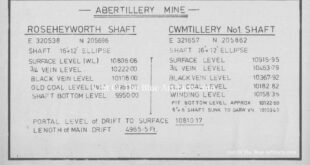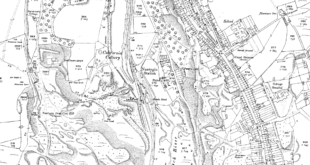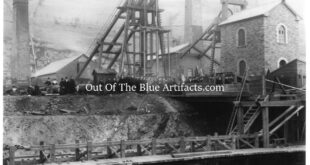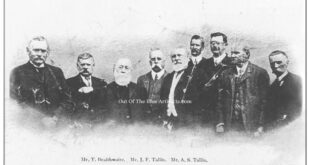Abertillery New Mine – Rose Heyworth and Cwmtillery Collieries Shaft Depth Details Both collieries, Rose Heyworth and Cwmtillery had always been connected since the Rose Heyworth Colliery was established and sunk in 1874-75. At that time Mr Joseph Wallace (Manager of Cwmtillery Colliery) and Mr William Adams (Mining Engineer of Cardiff) drove a connecting tunnel from Cwmtillery to the newly …
Read More »History of the Gwent Collieries
California Colliery Level – Nantyglo
California Colliery. The California Colliery Level (as seen in the centre of the map from 1920) just opposite the Nantyglo Station was opened by Mr Silvanus Jones Jnr in October 1904. In 1915 the collieries were taken over by Silvanus Jones & Co. (S Jones & Co). In November 1920 it was announced that Mr Silvanus Jones of the Woodlands, …
Read More »Penybont Cwmtillery – By Product Works & Coke Ovens
Penybont Cwmtillery – By Product Works, Washery & Coke Ovens. Prior to 1911 the Cwmtillery Coke Ovens were located in the grounds of Cwmtillery Colliery. Following is a Link to – The Original Coke Ovens at Cwmtillery Colliery The By-Product Plant. The map (left) shows the area in 1901, about ten years before the by-product plant, washery and coke works …
Read More »Mr J. P. D. Williams – Blaina Collieries
Mr J. P. D. Williams M.E. – General Manager of the Blaina Collieries. Mr J. P. D. Williams was born in 1834 at Nantyglo, Monmouthshire. His family lived on the Garn, Nantyglo and at 11 years of age he started work in the coalmines. His first job was in the “Little Pit” Blaina, under his brother-in-law Mr Thomas Lewis the …
Read More »Cwmtillery Colliery – Experiments with Iron Pit Props
Cwmtillery Colliery Experiments with Iron Pit Props. In October 1929 an article in the “Ebbw Vale Works Magazine” stated, “experiments with iron pit-props conducted at Cwmtillery Colliery had proved successful”. The number of iron props in use were 12,107 and the number of flats were 2,177. As a result of the change from wooden props to iron props the timber …
Read More »De-Watering Drivage Rose Heyworth Colliery
De-Watering Drivage Rose Heyworth Colliery. In late 1980 the National Coal Board authorities had concerns of water affecting the Six Bells Colliery workings, the source of which was believed to have been from underground reservoirs located somewhere under the Arael Mountain between Rose Heyworth Colliery and Six Bells. They decided to open a Dewatering Drivage, a tunnel from Rose Heyworth …
Read More »Llanerch Colliery
Llanerch Colliery – Cwm-nant-ddu. Llanerch Colliery originally known as Cwm-nant-ddu was sunk in about the mid 1840’s. Its early history is a bit confusing and unclear at present though it seems industry in the area started between 1825-1830. The iron works commenced in the 1830’s with an approximate workforce of 3,000 hands under the name of the British Iron Works. …
Read More »Colliery Canteens
Colliery Canteens. The idea of a colliery canteen was first raised in the “National Food Journal” in October 1918. The headline was “Details of South Wales Scheme”, pithead restaurants. The suggestion was made by Mr T. C. Jones the director of ships stores. He said there were small eating rooms, restaurants attached to the munition factories and small arms works …
Read More »Cwmtillery Colliery – Steam Winder Indicator
Cwmtillery Colliery Steam Winder Indicator. This brass hand was used to indicate the position of the cages in the shaft during winding. This indicator hand is from Cwmtillery Colliery, Abertillery. These brass indicator hands were taken from the colliery when the steam winding engines were replaced with electrical winders sometime in the 1940’s or 1950’s. There were two winders in …
Read More »Mines Rescue Station – Crumlin
Mines Rescue Station – Crumlin. The featured photograph above is of the committee of the Monmouthshire Colliery Owners Rescue Association 1910. The Crumlin Rescue Station. In July 1910 the Crumlin Rescue Station was established and officially opened on Saturday 9th of July 1910. It was the first rescue station in Monmouthshire and only the second in South Wales. The first …
Read More » Out Of The Blue Artifacts A Library of a lifetime of collecting
Out Of The Blue Artifacts A Library of a lifetime of collecting








